英语句子成分 结构分析+作文万能句子短语
英语作文万能语法和句子
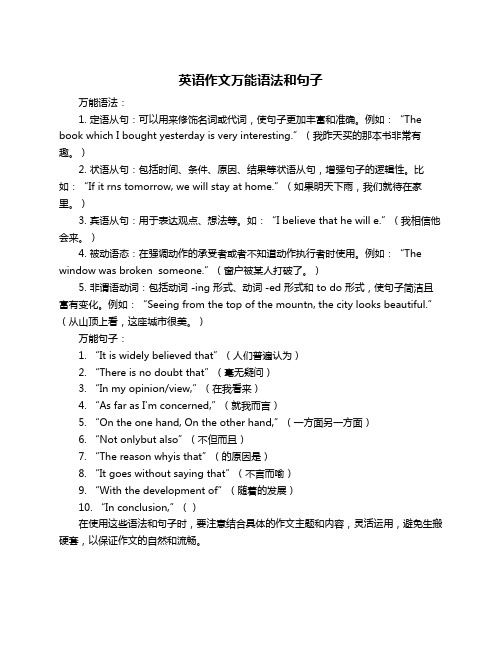
英语作文万能语法和句子万能语法:1. 定语从句:可以用来修饰名词或代词,使句子更加丰富和准确。
例如:“The book which I bought yesterday is very interesting.”(我昨天买的那本书非常有趣。
)2. 状语从句:包括时间、条件、原因、结果等状语从句,增强句子的逻辑性。
比如:“If it rns tomorrow, we will stay at home.”(如果明天下雨,我们就待在家里。
)3. 宾语从句:用于表达观点、想法等。
如:“I believe that he will e.”(我相信他会来。
)4. 被动语态:在强调动作的承受者或者不知道动作执行者时使用。
例如:“The window was broken someone.”(窗户被某人打破了。
)5. 非谓语动词:包括动词 -ing 形式、动词 -ed 形式和 to do 形式,使句子简洁且富有变化。
例如:“Seeing from the top of the mountn, the city looks beautiful.”(从山顶上看,这座城市很美。
)万能句子:1. “It is widely believed that”(人们普遍认为)2. “There is no doubt that”(毫无疑问)3. “In my opinion/view,”(在我看来)4. “As far as I'm concerned,”(就我而言)5. “On the one hand, On the other hand,”(一方面另一方面)6. “Not onlybut also”(不但而且)7. “The reason whyis that”(的原因是)8. “It goes without saying that”(不言而喻)9. “With the development of”(随着的发展)10. “In conclusion,”()在使用这些语法和句子时,要注意结合具体的作文主题和内容,灵活运用,避免生搬硬套,以保证作文的自然和流畅。
英语作文常用万能句式结构有哪些

英语作文常用万能句式结构有哪些英语作文常用万能句式结构在写作中起着至关重要的作用,它们能够有效提高文采和表达能力,使文章更加流畅和有逻辑。
以下是一些常用的英语作文句式结构:1. 引言句式•开头段落通常以简单明了的陈述句开始。
例如:“In today’s society, the issue of… has become a topic of greatconcern.”•引用名人名言或相关数据,如:“According to a recent survey, more than 60% of people believe that…”2. 表达观点句式•表示认同观点:“I agree with the statement that…”•表示反对观点:“However, I hold the opinion that…”3. 举例句式•举例论证:“For example, a recent study has shown that…”•举反例说明:“On the other hand, there are also instances where…”4. 结果句式•归纳总结:“In conclusion, it can be seen that…”•预测未来:“Therefore, it is likely that… in the future.”5. 建议建议句式•提出建议:“Therefore, it is advisable that…”•针对性建议:“To address this issue, it is necessary to…”6. 转折比较句式•对比观点:“While some people believe that…, others argue that…”•转折说明:“However, the reality is quite different from what was expected.”7. 引用观点句式•引用专家观点:“According to Professor Smith…”•引用调查结果:“A recent survey indicates that…”8. 表达看法句式•表明态度:“I firmly believe that…”•表达怀疑:“There is some doubt as to whether…”9. 解释原因句式•解释定因:“The reason for this phenomenon can be attributed to…”•解释位因:“Another factor contributing to this issue is…”10. 进一步阐述句式•深入解释:“Furthermore, it is essential to consider…”•表示重要性:“Moreover, it should be noted that…”以上是针对英语作文常用万能句式结构的一些常见范例及运用方式。
英语作文万能句子结构

英语作文万能句子结构在英语写作中,句子结构的丰富和多样性对于提高文章质量和表达能力至关重要。
本文将探讨英语作文中常用的万能句子结构,帮助读者在写作过程中更加自如地运用各种句型,使文章更加地丰富和有深度。
主题句型1.让步状语从句:尽管……,但是……–Example: 尽管环境保护意识已经增强,但是空气污染依然是一个严重的问题。
2.条件状语从句:如果……,就会……–Example: 如果每个人都能意识到自己的责任,就会迅速改善环境问题。
3.因果状语从句:由于……,所以……–Example: 由于全球变暖的现象日益显著,所以我们必须采取紧急行动来阻止这一现象的加剧。
表达观点1.中心论点句:本人认为……–Example: 本人认为科技的发展对社会产生的影响是不可避免的。
2.引语句式引出观点:有人认为……–Example: 有人认为学生应该将更多的时间投入学习,而不是玩耍。
3.提示性疑问句引出观点:难道不是吗?–Example: 近年来,环境问题引起了人们的广泛关注,难道不是吗?衔接段落1.过渡词句:更重要的是……–Example: 保护环境不仅仅是政府的责任,更重要的是每个人都应该意识到自己的责任。
2.总结句:综上所述,……–Example: 综上所述,我们要共同努力来改善环境问题,只有这样我们的地球才能持续地美丽。
结尾句型1.重述观点:再次强调……–Example: 再次强调,环境问题是当今社会面临的一个关键挑战,我们需要共同努力来解决。
2.建议性语气:希望……–Example: 希望政府能够出台更加严格的环境法律和政策,以有效解决环境问题。
在英语作文中,合理运用各种句子结构可以使文章行文流畅,逻辑性强,并且表达更加清晰明了。
希望读者能够通过本文介绍的万能句子结构,在写作中更加得心应手,提高文章的质量和表达能力。
高中英语的作文的万能句式分析

高中英语的作文的万能句式分析1. It goes without saying that+句子= It is obvious that句子 = Obviously, S. + V. 不用说,很明显.例如:It goes without saying that everyone should keep a balanced diet for the benefit of health.不用说,为了健康,每个人都应该保持平衡的膳食。
2. I am greatly convinced that句子…. 我深信… 例如:I am greatly convinced that we can improve our writing if we insist on reciting someuseful sentences. 我深信,只要我们坚持每天背一些有用的句子,我们就可以提高我们的英语写作。
3. It can be easily proved that句子… 很容易证明….例如:It can be easily proved that nothing is more precious than time.4. There is no doubt that句子… 毫无疑问地? 例如:There is no doubt that nearsightedness is a serious problem among the youth of our country.毫无疑问,近视在我国的年轻人中是一个严重的题。
5. According to my personal experience, … 根据我个人经验?…例如:According to my personal experience, friends bring me not only trust, understanding, but also warmth.据我个人经验,朋友给我的不仅是信任理解,更是温暖。
英语作文句子结构整理(独家)
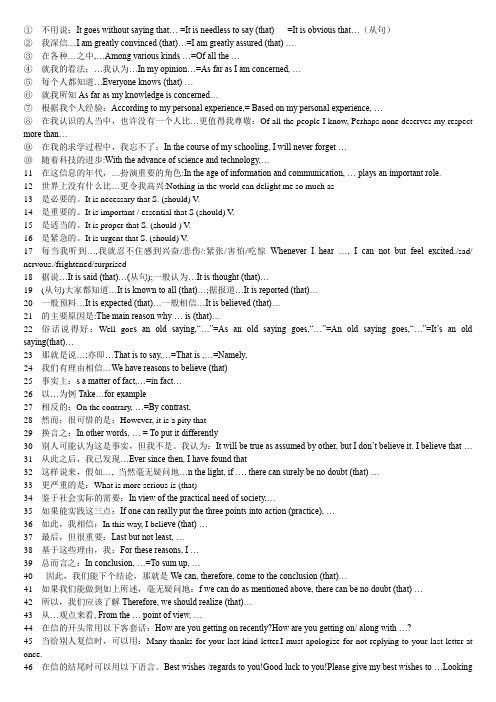
①不用说:It goes without saying that… =It is needless to say (that) =It is obvious that…(从句)②我深信…I am greatly convinced (that)…=I am greatly assured (that) …③在各种…之中,…Among various kinds …=Of all the …④就我的看法;…我认为…In my opinion…=As far as I am concerned, …⑤每个人都知道…Everyone knows (that) …⑥就我所知As far as my knowledge is concerned…⑦根据我个人经验:According to my personal experience,= Based on my personal experience, …⑧在我认识的人当中,也许没有一个人比…更值得我尊敬:Of all the people I know, Perhaps none deserves my respect more than…⑨在我的求学过程中,我忘不了:In the course of my schooling, I will never forget …⑩随着科技的进步:With the advance of science and technology,…11在这信息的年代,…扮演重要的角色:In the age of information and communication, … plays an important role.12世界上没有什么比…更令我高兴:Nothing in the world can delight me so much as13是必要的。
It is necessary that S. (should) V.14是重要的。
英语高分作文万能句型

1.引言句型:It is universally acknowledged that...众所周知With the development of society,we come to realize that...随着社会的发展,我们开始意识到2.表达观点句型:From my perspective,I firmly believe that...在我看来,我坚信I am convinced that...我确信3.举例说明句型:For instance,we may take...as an example.例如,我们可以以为例。
A case in point is...一个恰当的例子是4.对比和对照句型:On the one hand,...On the other hand,...一方面,另一方面,Compared with...,it can be seen that...与相比,可以看出5.原因分析句型:There are several factors responsible for...有几个因素对负责。
The reasons for...are as follows.的原因如下。
6.结果阐述句型:As a result,we can come to the conclusion that...因此,我们可以得出结论Therefore,it can be inferred that...因此,可以推断出7.提出建议句型:It is advisable to take the following measures.建议采取以下措施。
There is no doubt that enough concern must be paid to the problem of...毫无疑问,必须足够关注的问题。
8.总结句型:In conclusion,it is imperative that...总之,是必要的。
英语作文必备万能句型结构及例句
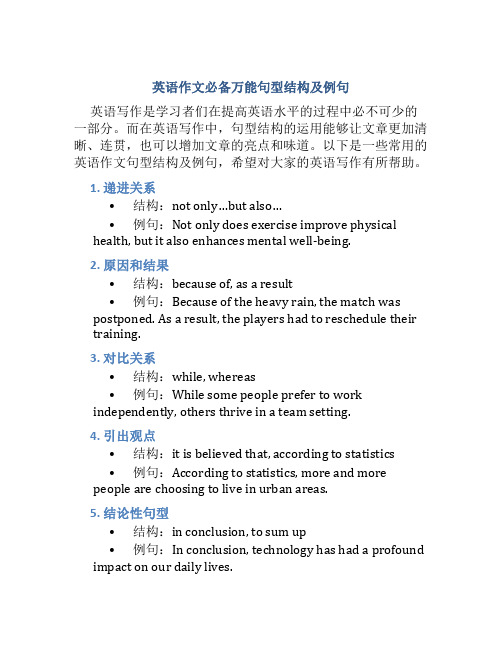
英语作文必备万能句型结构及例句英语写作是学习者们在提高英语水平的过程中必不可少的一部分。
而在英语写作中,句型结构的运用能够让文章更加清晰、连贯,也可以增加文章的亮点和味道。
以下是一些常用的英语作文句型结构及例句,希望对大家的英语写作有所帮助。
1. 递进关系•结构:not only…but also…•例句:Not only does exercise improve physical health, but it also enhances mental well-being.2. 原因和结果•结构:because of, as a result•例句:Because of the heavy rain, the match was postponed. As a result, the players had to reschedule their training.3. 对比关系•结构:while, whereas•例句:While some people prefer to work independently, others thrive in a team setting.4. 引出观点•结构:it is believed that, according to statistics•例句:According to statistics, more and more people are choosing to live in urban areas.5. 结论性句型•结构:in conclusion, to sum up•例句:In conclusion, technology has had a profound impact on our daily lives.6. 表达建议•结构:it is recommended that, the best solution is to•例句:It is recommended that students form study groups to improve their academic performance.7. 引出例子•结构:for example, such as•例句:Many animals, such as elephants and lions, are in danger of extinction.8. 引用他人观点•结构:according to, as stated by•例句:As stated by the expert, climate change is the biggest challenge of our time.以上是一些常用的英语作文句型结构及例句,希望能够帮助大家在英语写作中更加得心应手。
英语作文高分句子结构

英语作文高分句子结构当谈到写高分英语作文时,一个关键是使用多样化且精确的句子结构。
以下是一些常用的句子结构,可以帮助你提高作文的质量和得分:1. 主谓结构:Dogs bark. (主+谓)。
The students study diligently. (主+谓+宾)。
2. 主谓宾结构:She reads books. (主+谓+宾)。
He writes articles. (主+谓+宾)。
3. 主谓宾补结构:She considers herself a writer. (主+谓+宾+补)。
He painted the walls blue. (主+谓+宾+补)。
4. 并列句:She likes to read, and he likes to write. (句+连词+句)。
The sun was shining, but the wind was cold. (句+连词+句)。
5. 复合句:Although it was raining, she went for a walk. (从句+主句)。
He studied hard because he wanted to pass the exam. (主句+从句)。
6. 状语从句:When he arrived, the party had already started. (状语从句+主句)。
Because she was tired, she went to bed early. (因果状语从句+主句)。
7. 定语从句:The book that she is reading is very interesting. (定语从句+主句)。
The house where he lives is old. (定语从句+主句)。
8. 强调句:It was she who won the competition. (强调句式)。
9. 倒装句:Not only does he speak English well, but he also speaks French fluently. (倒装句)。
英语句子成分、结构分析+作文万能句子短语

句子成分分析7. Please make yourself at home .(介词短语)你请自便。
四 表语:放在连系动词 be ,bee, seem, feel turn(当“变得”讲时)等之后,用来说明主语的特征,状 态,身份等,可以充当表语的词有名词,动词-ed 形式或句子 1. He became king when he was only a child.(名词) 句子成分划分巧计主在前,谓在中,宾语状语后面冲。
短语定语住宾后,形代定语住宾前。
间宾直宾紧相连,直间之间to, for 连。
宾补位于宾语后,地状常在时状前。
2. The book is hers. (代词)3. He is free today.(形容词)一, 主语:是一个句子的主体,一般放在谓语之前,是动作的实施者。
主语由名词,代词,数词,不定式,动词-ing 形式或从句充当。
1. Mary is a good student.(名词) 4. Her mother will be back soon.(副词) 5. I ’m sixteen.(数词)6. He seemed worried about it.(动词过去分词) 2. Unity is strength. ( 名词)3. He enjoys walking in the fields. (代词) 7. It is surprising to hear the news.(动词现在分词)8. The problem is how to finish the work ahead of time.(不定式短语) 9. This is what I want to tell you .(从句,即表语从句)五 定语:用来修饰名词或代词,可作定于的词有名词,代词,数词,介词短语,不定式,动词 -ing 形 式,动词-ed 形式以及从句,定语分为前置定语和后置定语 1. Yao Ming is an excellent basketball player.(形容词,前置) 2. Ronaldo is a football player.(名词,前置) 4. Four plus six is ten.(数词)5. To work hard is important.(不定式短语)6. It is my job to teach them English. (不定式短语是真正的主语,it 为形式主语)7. Smoking is bad for health. (动词-ing 形式作主语)8. When we shall go back has not been decided yet. (从句作主语,即主语从句)二, 谓语:用来说明主语的动作或状态,表明主语是什么,做什么,或怎么样。
英语作文万能句子及语法
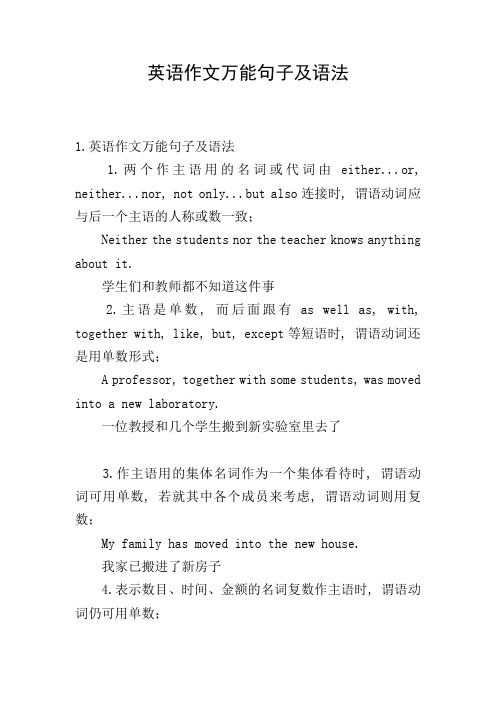
英语作文万能句子及语法1.英语作文万能句子及语法1.两个作主语用的名词或代词由either...or, neither...nor, not only...but also连接时, 谓语动词应与后一个主语的人称或数一致;Neither the students nor the teacher knows anything about it.学生们和教师都不知道这件事2.主语是单数, 而后面跟有as well as, with, together with, like, but, except等短语时, 谓语动词还是用单数形式;A professor, together with some students, was moved into a new laboratory.一位教授和几个学生搬到新实验室里去了3.作主语用的集体名词作为一个集体看待时, 谓语动词可用单数, 若就其中各个成员来考虑, 谓语动词则用复数;My family has moved into the new house.我家已搬进了新房子4.表示数目、时间、金额的名词复数作主语时, 谓语动词仍可用单数;The dollars is too cheap for this pair of shoes.这双鞋10元钱太便宜了5.两个或两个以上的并列主语由and连接时, 如果表示不同概念, 谓语动词用复数, 如果表示同一概念, 谓语动词要用单数;The singer and dancer comes from Guangxi.那位歌舞演员来自广西。
(同一人)Wu Dong and Wu Xi are twin brothers.吴东和吴西是孪生兄弟6.each, either, neither或由some, any, no, every 构成的合成代词作主语时, 谓语动词用单数;Neither of them is interested in English.他们两人都对英语不感兴趣7、none作主语时, 谓语动词可用单数或复数;None knows(或know) a great deal about this experiment.没有一个人对这项实验知道得很多8、代词what, who, which, any, all, most, more等作主语时, 谓语动词用单数还是复数主要由它们所代替的意义决定;All of the students have seen the film.所有的学生都看过这部电影9、people, police, cattle等作主语时, 谓语动词用复数;The people in the city are very friendly.那个城市的人很友好10、用“every, each, no或many a(或 a great deal of)+ 单数名词”作主语时, 谓语动词用单数, 而“a great many(或 a great number of 等)+复数名词”作主语时, 谓语动词则用复数;Many a student and teacher is watching the football match.许多学生和老师正在观看足球比赛2.英语作文万能句子及语法1.Som.peopl.thin.tha.….有些人认为2.T.b.frank..ca.no.agre.wit.thei.opinio.fo.th.reaso n.below.坦率地说,我不能同意他们的意见,理由如下。
英语作文常用万能句式结构分析
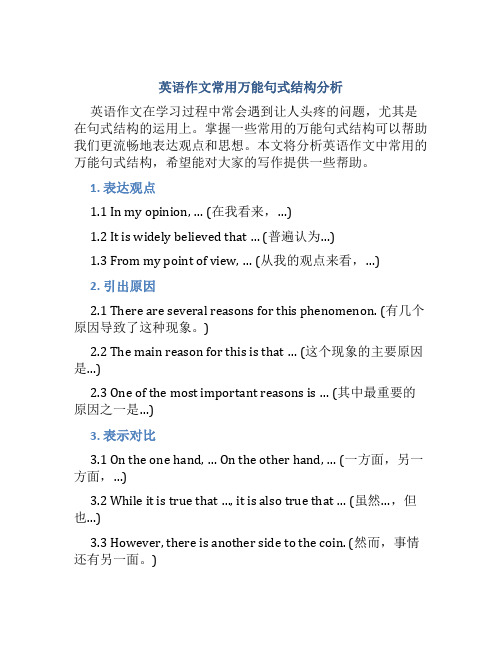
英语作文常用万能句式结构分析英语作文在学习过程中常会遇到让人头疼的问题,尤其是在句式结构的运用上。
掌握一些常用的万能句式结构可以帮助我们更流畅地表达观点和思想。
本文将分析英语作文中常用的万能句式结构,希望能对大家的写作提供一些帮助。
1. 表达观点1.1 In my opinion, … (在我看来,…)1.2 It is widely believed that … (普遍认为…)1.3 From my point of view, … (从我的观点来看,…)2. 引出原因2.1 There are several reasons for this phenomenon. (有几个原因导致了这种现象。
)2.2 The main reason for this is that … (这个现象的主要原因是…)2.3 One of the most important reasons is … (其中最重要的原因之一是…)3. 表示对比3.1 On the one hand, … On the other hand, … (一方面,另一方面,…)3.2 While it is true t hat …, it is also true that … (虽然…,但也…)3.3 However, there is another side to the coin. (然而,事情还有另一面。
)4. 举例4.1 For example, … (举例来说,…)4.2 A good case in point is … (一个很好的例子是…)4.3 Take … as an example. (拿…来举例子。
)5. 结论5.1 In conclusion, … (总的来说,…)5.2 To sum up, … (总之,…)5.3 Given the factors mentioned, it can be concluded that … (考虑到以上因素,可以得出结论…)通过以上句式结构的分析,我们可以发现,在英语作文中,合理运用这些常用的句式可以更好地组织文章结构,使文章表达更清晰、连贯。
45个英语作文万能句式

45个英语作文万能句式Introduction:As we all know, good writing skills are essential for effective communication. One of the keys to good writing is the use of varied sentence structures. In this essay, Iwill discuss 45 useful English sentence structures that can help you improve your writing skills.1. Simple sentence: A simple sentence consists of one independent clause and expresses a complete thought. Example: She is a talented singer.2. Compound sentence: A compound sentence consists of two or more independent clauses joined by a coordinating conjunction (and, but, or, nor, for, yet, so). Example: She is a talented singer, but she is also a skilled dancer.3. Complex sentence: A complex sentence consists of one independent clause and one or more dependent clauses.Example: Because she is a talented singer, she has many fans.4. Compound-complex sentence: A compound-complex sentence consists of two or more independent clauses andone or more dependent clauses. Example: She is a talented singer, but she is also a skilled dancer, and because she has many fans, she is always in demand.5. Inverted sentence: An inverted sentence is asentence in which the subject comes after the verb. Example: In the garden sat a little girl.6. Interrogative sentence: An interrogative sentence asks a question. Example: What is your name?7. Imperative sentence: An imperative sentence gives a command or makes a request. Example: Please pass me the salt.8. Exclamatory sentence: An exclamatory sentence expresses strong emotion. Example: What a beautiful day!9. Parallel structure: Parallel structure is the repetition of a grammatical structure within a sentence or paragraph. Example: She likes to sing, dance, and act.10. Repetition: Repetition is the use of the same word or phrase multiple times. Example: She was happy, happy, happy.11. Appositive: An appositive is a noun or noun phrase that renames or explains another noun or noun phrase. Example: My friend, the doctor, is coming over.12. Parenthetical expression: A parenthetical expression is a word or phrase inserted into a sentence as an explanation or afterthought. Example: She is, in my opinion, the best singer in the world.13. Absolute phrase: An absolute phrase is a group of words that modifies the entire sentence and is not connected grammatically to any single word in the sentence. Example: Her eyes sparkling with joy, she ran to greet herfriend.14. Participial phrase: A participial phrase consists of a participle (a verb ending in -ing or -ed) and any modifiers or complements. Example: Walking down the street, she saw a beautiful flower.15. Gerund phrase: A gerund phrase consists of a gerund(a verb ending in -ing used as a noun) and any modifiers or complements. Example: Swimming is good exercise.16. Infinitive phrase: An infinitive phrase consists of an infinitive (to + verb) and any modifiers or complements. Example: To run a marathon is her goal.17. Adjective clause: An adjective clause is a dependent clause that modifies a noun or pronoun. Example: The book that she recommended was excellent.18. Adverb clause: An adverb clause is a dependent clause that modifies a verb, adjective, or other adverb. Example: She sang beautifully, as if she were an angel.19. Noun clause: A noun clause is a dependent clausethat functions as a noun. Example: I don't know what to do.20. Relative clause: A relative clause is a dependent clause that modifies a noun or pronoun and is introduced by a relative pronoun (who, whom, whose, which, that). Example: The girl who is singing is my friend.21. Conditional sentence: A conditional sentence expresses a hypothetical situation and its consequences. Example: If it rains, we will stay inside.22. Passive voice: In the passive voice, the subject receives the action of the verb. Example: The cake wasbaked by my mother.23. Active voice: In the active voice, the subject performs the action of the verb. Example: My mother bakedthe cake.24. Direct speech: Direct speech is the exact wordsspoken by a person, enclosed in quotation marks. Example: "I love you," he said.25. Indirect speech: Indirect speech is reporting what someone said without using their exact words. Example: He said that he loved her.26. Ellipsis: Ellipsis is the omission of words that are understood from the context. Example: She can play the piano, but he cannot.27. Coherence: Coherence is the logical and orderly connection of ideas in a text. Example: The essay was well-organized and easy to follow.28. Cohesion: Cohesion is the use of transitional words and phrases to connect ideas in a text. Example: In addition, Furthermore, Moreover, Therefore, However, Nevertheless.29. Connotation: Connotation is the emotional or cultural association attached to a word or phrase. Example:The word "home" has positive connotations of warmth and security.30. Denotation: Denotation is the literal or dictionary definition of a word or phrase. Example: The word "home" refers to a place where one lives.31. Irony: Irony is the use of words to convey a meaning that is opposite of its literal meaning. Example: "What a lovely day," she said sarcastically.32. Metaphor: A metaphor is a figure of speech in whicha word or phrase is applied to an object or action to which it is not literally applicable. Example: The world is a stage.33. Simile: A simile is a figure of speech that compares two things using "like" or "as". Example: She is as beautiful as a rose.34. Personification: Personification is a figure of speech in which human qualities are attributed to non-humanthings. Example: The wind whispered through the trees.35. Hyperbole: Hyperbole is a figure of speech in which exaggeration is used for emphasis or effect. Example: I have a million things to do.36. Alliteration: Alliteration is the repetition of the same sound at the beginning of adjacent or closely connected words. Example: Peter Piper picked a peck of pickled peppers.37. Onomatopoeia: Onomatopoeia is the use of words that imitate the sounds they describe. Example: The clock tick-tocked.38. Rhyme: Rhyme is the repetition of the same sound at the end of words. Example: Jack and Jill went up the hill.39. Assonance: Assonance is the repetition of vowel sounds in nearby words. Example: The cat sat on the mat.40. Consonance: Consonance is the repetition ofconsonant sounds in nearby words. Example: Sally sells seashells by the seashore.41. Antithesis: Antithesis is the use of contrasting ideas or words within a sentence or paragraph. Example: It was the best of times, it was the worst of times.42. Oxymoron: An oxymoron is a figure of speech in which contradictory terms are used together. Example: Jumbo shrimp.43. Paradox: A paradox is a statement that appears to be contradictory but actually contains a hidden truth. Example: Less is more.44. Euphemism: A euphemism is a mild or indirect word or expression used in place of one considered to be too harsh or blunt. Example: He passed away instead of he died.45. Idiom: An idiom is a phrase or expression that hasa figurative meaning different from the literal meaning of the words. Example: It's raining cats and dogs.Conclusion:In conclusion, using varied sentence structures can greatly improve your writing skills. By incorporating these 45 English sentence structures into your writing, you can make your writing more interesting, engaging, and effective. So go ahead and experiment with these sentence structuresto take your writing to the next level!。
英语作文写作高分句型结构分析
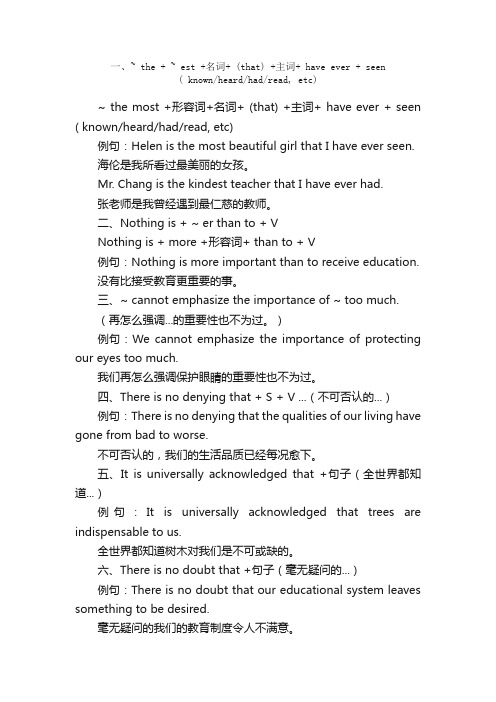
一、~ the + ~ est +名词+ (that) +主词+ have ever + seen( known/heard/had/read, etc)~ the most +形容词+名词+ (that) +主词+ have ever + seen ( known/heard/had/read, etc)例句:Helen is the most beautiful girl that I have ever seen.海伦是我所看过最美丽的女孩。
Mr. Chang is the kindest teacher that I have ever had.张老师是我曾经遇到最仁慈的教师。
二、Nothing is + ~ er than to + VNothing is + more +形容词+ than to + V例句:Nothing is more important than to receive education.没有比接受教育更重要的事。
三、~ cannot emphasize the importance of ~ too much.(再怎么强调...的重要性也不为过。
)例句:We cannot emphasize the importance of protecting our eyes too much.我们再怎么强调保护眼睛的重要性也不为过。
四、There is no denying that + S + V ...(不可否认的...)例句:There is no denying that the qualities of our living have gone from bad to worse.不可否认的,我们的生活品质已经每况愈下。
五、It is universally acknowledged that +句子(全世界都知道...)例句:It is universally acknowledged that trees are indispensable to us.全世界都知道树木对我们是不可或缺的。
英语作文十大万能句型结构
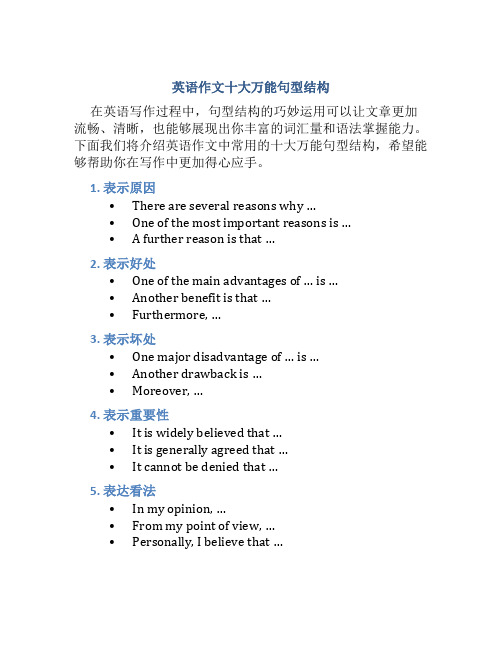
英语作文十大万能句型结构在英语写作过程中,句型结构的巧妙运用可以让文章更加流畅、清晰,也能够展现出你丰富的词汇量和语法掌握能力。
下面我们将介绍英语作文中常用的十大万能句型结构,希望能够帮助你在写作中更加得心应手。
1. 表示原因•There are several reasons why …•One of the most important reasons is …• A further reason is that …2. 表示好处•One of the main advantages of … is …•Another benefit is that …•Furthermore, …3. 表示坏处•One major disadvantage of … is …•Another drawback is …•Moreover, …4. 表示重要性•It is widely believed that …•It is generally agreed that …•It cannot be denied that …5. 表达看法•In my opinion, …•From my point o f view, …•Personally, I believe that …6. 表示对比•On the one hand, …•On the other hand, …•In contrast, …7. 表示条件•If …, then …•Unless …, …•Provided that …8. 表示结论•In conclusion, …•To sum up, …•Therefore, …9. 表示建议•It is recommended that …•One possible solution is to …•It would be advisable to …10. 表示例证•For example, …• A case in point is …•Such as …以上就是英语作文中常用的十大万能句型结构,希望你能灵活运用,让你的英语写作更加出色!。
英语句子成分及结构解析精选全文完整版

My watch is gone / missing / lost. (形容词化的分词)
To wear a flower is to say “I’m poor, I can’t buy a ring. (不定式)
The question is whether they will come(. 表语从句)
keep, leave, sell, show等。
(五).补语
补语(complement)是一种补足主语和宾语 的意义的句子成分。补足主语意义的句子 成分叫做主语补语(subject complement), 补足宾语意义的句子成分叫做宾语补语 (object complement).
对宾语的补充,全称为宾语补足语。 We elected him monitor. (名词) We will make them happy. (形容词) We found nobody in. (副词) Please make yourself at home. (介词短语) Don’t let him do that. (省to不定式)
(四).宾语
1)动作的承受者-----动宾 I like China. (名词) He hates you. (代词) How many do you need? We need two.(数词) I enjoy working with you. (动名词)
I hope to see you again. (不定式) Did you write down what he said?(宾语从句)
2) 介词后的名词、代词和动名词-----介宾 Are you afraid of the snake?
Under the snow, there are many rocks. 3) 双宾语-----间宾(指人)和直宾(指物) He gave me a book yesterday.
英语各类型作文万能句子结构
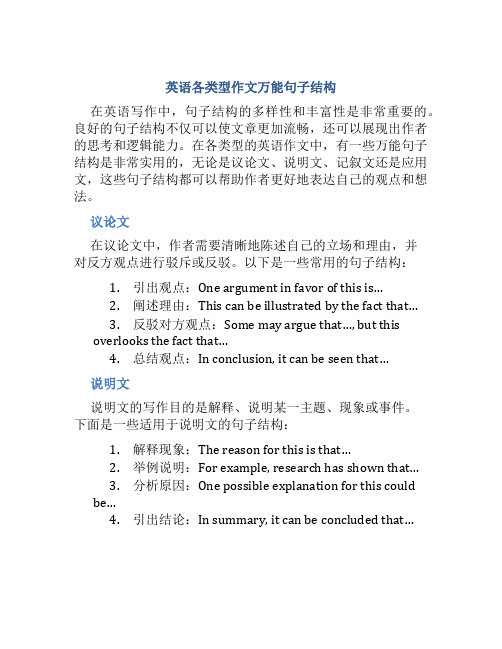
英语各类型作文万能句子结构在英语写作中,句子结构的多样性和丰富性是非常重要的。
良好的句子结构不仅可以使文章更加流畅,还可以展现出作者的思考和逻辑能力。
在各类型的英语作文中,有一些万能句子结构是非常实用的,无论是议论文、说明文、记叙文还是应用文,这些句子结构都可以帮助作者更好地表达自己的观点和想法。
议论文在议论文中,作者需要清晰地陈述自己的立场和理由,并对反方观点进行驳斥或反驳。
以下是一些常用的句子结构:1.引出观点:One argument in favor of this is…2.阐述理由:This can be illustrated by the fact that…3.反驳对方观点:Some may argue that…, but thisoverlooks the fact that…4.总结观点:In conclusion, it can be seen that…说明文说明文的写作目的是解释、说明某一主题、现象或事件。
下面是一些适用于说明文的句子结构:1.解释现象:The reason for this is that…2.举例说明:For example, research has sh own that…3.分析原因:One possible explanation for this couldbe…4.引出结论:In summary, it can be concluded that…记叙文记叙文是以叙述事件或故事的方式来传达信息或情感。
以下是适用于记叙文的一些句子结构:1.开头引入:It all started when…2.时间顺序:Firstly, …, Secondly, …, Finally, …3.描写细节:The scene was set with…4.结尾总结:In the end, it turned out that…应用文应用文是指具有明确应用目的的文章,如求职信、邀请函等。
大学英语作文好用的句子结构

大学英语作文常用句型结构解析English essay writing in the college level demands a certain level of proficiency not only in vocabulary butalso in sentence structure. Effective sentence structures can help enhance the readability and clarity of your writing, making it easier for the reader to follow your arguments and ideas. In this article, we will explore some commonly used sentence structures that are particularly useful for college-level English essays.1. Topic sentences: These are the backbone of any essay, as they introduce the main idea or argument of a paragraph. Topic sentences should be clear and concise, immediately setting the tone and direction for the rest of the paragraph.Example: "The importance of critical thinking in the academic setting cannot be overstated, as it is the foundation upon which effective learning and understanding are built."2. Cause and effect sentences: These structures are useful for analyzing relationships between ideas or events.They help the reader understand why certain things happen and what the consequences of those actions might be.Example: "The increasing use of technology in education has had a profound impact on student learning, as it has allowed for more interactive and engaging classroom experiences."3. Compare and contrast sentences: These structures are useful for highlighting similarities and differences between two or more ideas, events, or objects. They help the reader gain a deeper understanding of the subject matter by comparing and contrasting different perspectives or viewpoints.Example: "While both traditional and online learning have their own advantages and disadvantages, online learning has become increasingly popular due to its flexibility and accessibility."4. Transitional sentences: Transitional sentences are crucial for maintaining the flow and coherence of an essay. They help the reader follow the thread of your argument as you move from one idea to another.Example: "However, despite these benefits, there are also some challenges associated with online learning that need to be addressed."5. Examples and illustrations: Including examples and illustrations in your sentences can help make your points more tangible and relatable for the reader. They provide concrete evidence to support your arguments and make them more persuasive.Example: "One example of this is the use of interactive whiteboards in classrooms, which allows teachers to present complex concepts in a visually appealing and easy-to-understand manner."In conclusion, using effective sentence structures is essential for writing college-level English essays. Topic sentences, cause and effect sentences, compare and contrast sentences, transitional sentences, and examples and illustrations are all valuable tools that can help youcraft clear, coherent, and persuasive essays. By mastering these structures, you can take your writing skills to the next level and impress your readers with your ability to communicate complex ideas effectively.**大学英语作文常用句型结构解析**大学英语作文不仅要求词汇丰富,还要求句型结构多样化。
有关于英语句子结构分析
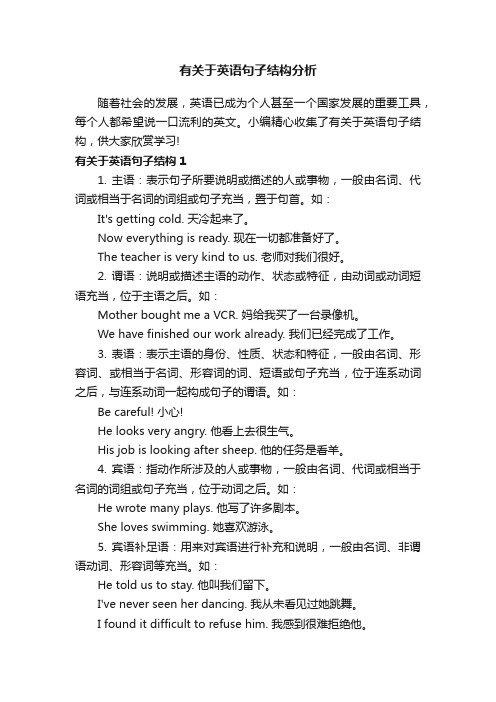
有关于英语句子结构分析随着社会的发展,英语已成为个人甚至一个国家发展的重要工具,每个人都希望说一口流利的英文。
小编精心收集了有关于英语句子结构,供大家欣赏学习!有关于英语句子结构11. 主语:表示句子所要说明或描述的人或事物,一般由名词、代词或相当于名词的词组或句子充当,置于句首。
如:It's getting cold. 天冷起来了。
Now everything is ready. 现在一切都准备好了。
The teacher is very kind to us. 老师对我们很好。
2. 谓语:说明或描述主语的动作、状态或特征,由动词或动词短语充当,位于主语之后。
如:Mother bought me a VCR. 妈给我买了一台录像机。
We have finished our work already. 我们已经完成了工作。
3. 表语:表示主语的身份、性质、状态和特征,一般由名词、形容词、或相当于名词、形容词的词、短语或句子充当,位于连系动词之后,与连系动词一起构成句子的谓语。
如:Be careful! 小心!He looks very angry. 他看上去很生气。
His job is looking after sheep. 他的任务是看羊。
4. 宾语:指动作所涉及的人或事物,一般由名词、代词或相当于名词的词组或句子充当,位于动词之后。
如:He wrote many plays. 他写了许多剧本。
She loves swimming. 她喜欢游泳。
5. 宾语补足语:用来对宾语进行补充和说明,一般由名词、非谓语动词、形容词等充当。
如:He told us to stay. 他叫我们留下。
I've never seen her dancing. 我从未看见过她跳舞。
I found it difficult to refuse him. 我感到很难拒绝他。
6. 定语:对名词或代词进行修饰、限制或说明,一般由形容词、名词、代词、数词、介词短语、非谓语动词及句子等充当,位置可在所修饰的词之前,也可在所修饰的词之后(详见形容词一章)。
英语句子成分分析(最完整版)
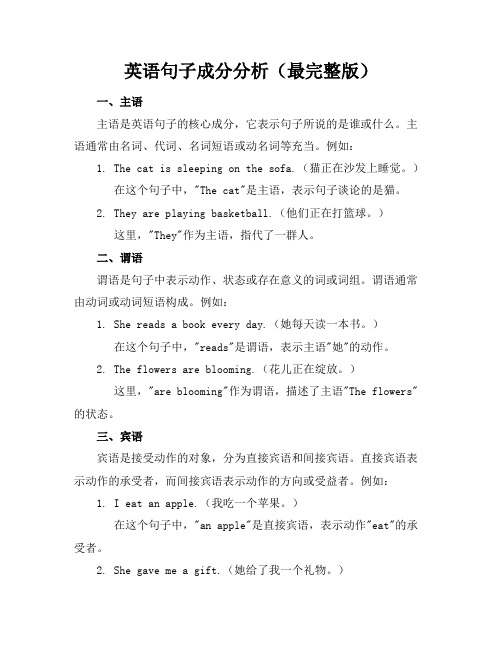
英语句子成分分析(最完整版)一、主语主语是英语句子的核心成分,它表示句子所说的是谁或什么。
主语通常由名词、代词、名词短语或动名词等充当。
例如:1. The cat is sleeping on the sofa.(猫正在沙发上睡觉。
)在这个句子中,"The cat"是主语,表示句子谈论的是猫。
2. They are playing basketball.(他们正在打篮球。
)这里,"They"作为主语,指代了一群人。
二、谓语谓语是句子中表示动作、状态或存在意义的词或词组。
谓语通常由动词或动词短语构成。
例如:1. She reads a book every day.(她每天读一本书。
)在这个句子中,"reads"是谓语,表示主语"她"的动作。
2. The flowers are blooming.(花儿正在绽放。
)这里,"are blooming"作为谓语,描述了主语"The flowers"的状态。
三、宾语宾语是接受动作的对象,分为直接宾语和间接宾语。
直接宾语表示动作的承受者,而间接宾语表示动作的方向或受益者。
例如:1. I eat an apple.(我吃一个苹果。
)在这个句子中,"an apple"是直接宾语,表示动作"eat"的承受者。
2. She gave me a gift.(她给了我一个礼物。
)这里,"a gift"是直接宾语,表示动作"gave"的承受者;"me"是间接宾语,表示动作的方向。
四、表语表语用来补充说明主语的身份、特征或状态,通常位于系动词(如be、look、seem等)之后。
例如:1. He is a teacher.(他是一名教师。
)在这个句子中,"a teacher"是表语,说明主语"He"的身份。
- 1、下载文档前请自行甄别文档内容的完整性,平台不提供额外的编辑、内容补充、找答案等附加服务。
- 2、"仅部分预览"的文档,不可在线预览部分如存在完整性等问题,可反馈申请退款(可完整预览的文档不适用该条件!)。
- 3、如文档侵犯您的权益,请联系客服反馈,我们会尽快为您处理(人工客服工作时间:9:00-18:30)。
句子成分分析句子成分划分巧计主在前,谓在中,宾语状语后面冲。
短语定语住宾后,形代定语住宾前。
间宾直宾紧相连,直间之间to, for 连。
宾补位于宾语后,地状常在时状前。
一,主语:是一个句子的主体,一般放在谓语之前,是动作的实施者。
主语由名词,代词,数词,不定式,动词-ing形式或从句充当。
1.Mary is a good student.(名词)2.Unity is strength. ( 名词)3.He enjoys walking in the fields. (代词)4.Four plus six is ten.(数词)5.To work hard is important.(不定式短语)6.It is my job to teach them English. (不定式短语是真正的主语,it 为形式主语)7.Smoking is bad for health. (动词-ing形式作主语)8.When we shall go back has not been decided yet. (从句作主语,即主语从句)二,谓语:用来说明主语的动作或状态,表明主语是什么,做什么,或怎么样。
谓语由动词担当,可由各种时态的动词表示1.Great hopes make great men. (动词)2.She looked after him two years ago.(动词词组)3.I shall answer your question after class.(助动词+动词)4.She can speak English very well. (情态动词+动词)5.The dictionary is mine.(连系动词+表语)6.She looks happy. (连系动词+表语)三,宾语:表示动作的对象,是动作的承受者,由名词,代词,不定式,相当于名词的词或从句充当充当,一般放在及物动词或介词的后面。
(一)单宾语1.Paper catches fire easily. (名词)2.He will do anything for her. (代词)3.She is listening to play the violin. (不定式短语)4.He doesn’t like swimming. (动词-ing形式)5.He said that he would come. (从句,即宾语从句)(二)双宾语(直接宾语sth+间接宾语sb)常见的带双宾语的动词有:give, bring, buy, get, lend, make, offer, pass, teach, tell, write, read, show, send, leave, return1.Mother bought me a shirt yesterday.2.She taught us English then.3.I send m y mother two letters last month.(三) 复合宾语(宾语+宾语补足语)有些及物动词带了宾语后,还需要有一个补足成分,才能使句意完整,即补充说明宾语,能都充当宾补的词有名词,形容词,副词,介词短语,不定式,分词(现在分词和过去分词)常跟宾补的动词有allow, ask, advise, call, elect, keep, consider, make, see, name, have, get, help, wish, let, feel, hear, find smell1.We elected him our monitor.(名词)2.I want him back.(副词)3.Cell phones make it possible for us to anyone from anywhere.(形容词)4.The doctor advised me to have more exercises.(不定式短语)5.I heard Mary singing in her room.(动词-ing形式)6.He had his watch repaired yesterday.(过去分词)7.Please make yourself at home.(介词短语)你请自便。
四表语:放在连系动词be ,become, seem, feel turn(当“变得”讲时)等之后,用来说明主语的特征,状态,身份等,可以充当表语的词有名词,动词-ed形式或句子1. He became king when he was only a child.(名词)2. The book is hers. (代词)3. He is free today.(形容词)4. Her mother will be back soon.(副词)5. I’m sixteen.(数词)6. He seemed worried about it.(动词过去分词)7. It is surprising to hear the news.(动词现在分词)8. The problem is how to finish the work ahead of time.(不定式短语)9. This is what I want to tell you.(从句,即表语从句)五定语:用来修饰名词或代词,可作定于的词有名词,代词,数词,介词短语,不定式,动词-ing 形式,动词-ed 形式以及从句,定语分为前置定语和后置定语1. Yao Ming is an excellent basketball player.(形容词,前置)2. Ronaldo is a football player.(名词,前置)3. Your hair needs cutting.(代词,前置)4. Thirty students attended the party.(数词,前置)5. He is in the sitting room.(现在分词,前置)6. You can see fallen leaves everywhere in fall.(过去分词,前置)7. Who is the girl dancing over there?(现在分词短语,后置)8. The hotel built last year is the best in the city.(过去分词短语,后置)9. This the house which we visied.(从句,即定语从句,后置)六状语:用来修饰形容词,副词,动词或整个句子,用来表示时间,地点,原因,方式,程度,目的,结果,条件,让步,频度等情况。
通常用作状语的词有副词,介词短语,不定式,动词-ing形式,动词-ed 形式,名词词组,从句等,状语一般放在词尾,但有的也放在句首或句中1.The plane will take off in a few minutes. (介词短语作地点状语)2.He came late because of the rain. (介词短语作原因状语)3.She cut the apple with the knife. (介词短语作方式状语)4.There are plenty of fish in the lake. (介词短语作地点状语)5.The river is very long. (副词作程度状语)6.He ran fast to catch the train.(不定式作目的状语)7.She woke suddenly to find him standing near the bed.(不定式作结果状语)8.Turning to the left, you will see the library.(现在分词作条件状语)9.Given another chance, he will succeed.(过去分词作条件状语)10.They walked in spite of the heavy snow.(介词短语作让步状语)11.He usually goes to bed at ten.(频度副词作状语)12.They are generous although they are poor. (从句作状语,让步状语从句)句子结构分析一简单句简单句只有一个主语(或并列主语)和一个谓语(或并列谓语)的句子。
We all learn English. (一个主语和一个谓语)My father and mother go to work at 7:00 in the morning.(一个并列主语和一个谓语)He once lived and worked there. ( 一个主语和一个并列谓语)英语句子万万千五大句型把线牵句型种类为动词后接什么是关键系词后面接表语Vi. 独身无牵挂Vt. 又可分三类单宾双宾最常见还有宾语补足语各种搭配记心间五种基本句型以及there be句型(一)主语+连系动词+表语1.He is a teacher.2.This love story is about a pop singer.3.Surfing is a popular water sport.4.The teacher seemed to be pleased with my work.(二) 主语+谓语(不及物动词vi.)1. Great changes have taken place.这种句型中常有状语We study hard.The book sells well.The shirt washes easily.(三) 主语+谓语(及物动词vt.)+宾语1. I enjoy surfing the Internet all the time.2. We study English.He thought about the problem for a few moments.(四) 主语+谓语(及物动词vt.)+间接宾语(sth.)+直接宾语(sb. )I gave him a present.---- I gave a present to him.The evening dress cost her forty dollars.The girl asked me whether I could repair the bike.(五) 主语+谓语(及物动词vt.)+宾语+宾语补足语We think the job easy.We elected Liu our monitor.There be +主语+谓语+状语(介词短语)There is a dictionary on the desk.There will be a sports meeting next week.二并列句:句子含有两个或两个以上互不依从的主谓结构,就是并列句1. 表示并列关系:这样的词有and ,not only…but also , as well asWork hard and you will pass the exams.2. 表示转折关系:这样的词有but, yet, still, whileShe is not beautiful, yet she is clever.The hamburger is not healthy, but I love it.Tom was poor while his brother became very rich.4.表示选择关系:这样的词有or, either… or… neither… nor… not…but… or else otherwise Either choose this pen or choose that one.You’ll have to go now, otherwise you’ll miss your bus.5.表示因果关系:这样的词有so , for, thereforeHe lost his job, so he was unhappy these days.It must have rained last night, for the road is wet.He has worked for many hours, therefore, he felt tired.三复合句: 是指包含两个或多个主谓结构结构的句子,其中一个是主句,其余为从句。
